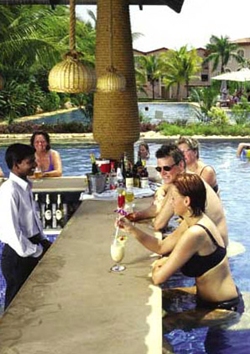Ever wondered what it would be like to photograph a holiday resort? A complete illustration of the beach resort building, the restaurants, balconies, swimming pools, cocktail bars, rooms, lobby, concierge, etc. Could take a little more than a couple of weeks, you think. And guess how long was the time allotted for this ‘dream’ assignment? Five days.
OK, so you are still interested, let me tell you a little more about the assignment … the photographs were to go into a very special book about the resort, of which only six were going to be printed. Heavy gloss paper stock, hard cover bound, each book was going to cost over $1,000 just in printing costs.

Still interested? Still sure you could complete this photo shoot in five days? Now let me fill you in even more. The resort was not yet built. The only physical items about the resort were the architect’s model, and the building illustrations showing the rooms, pools and everything else. The book was going to be used to raise the financial backing by appealing to foreign entrepreneurs. Some assignment, but I was the new boy on the block, and realized that if I could pull this off, I would get more assignments from this particular art director. I should also point out that this was before digital imaging, Photoshop and the like. It was all shot on slide film (transparency).
I tackled the most difficult shot first. That was inserting a photograph of the architect’s model on to the vacant lot in the built up seaside area. This required exacting planning. I needed to know the exact height of the proposed resort tower, plus the heights of the already existing buildings which would be around the proposed resort.
Next was to hire a helicopter to be able to get the aerial shot. Up we went and after composing this shot, I needed to know the height we were at, the lens I was using and the position of the sun. This data was all written down. The helicopter shot ended up taking one day.
The next shot was that of the architect’s model. The scaling had to be done so that the resort would appear at the correct height versus the other buildings around it. The studio lighting had to be placed to be the equivalent of the sun’s position during the aerial filming and the camera position had to be of the same relativity as the helicopter’s height when I took the photo, and using the same focal length lens. It took one day in the studio, with me up a ladder and the assistant moving flash heads.
The two shots – the seaside area and the architect’s model were then given to the lab to be combined. If I had made any errors it would become obvious in the final combination.
The next shots also took much planning. Monogrammed napkins, pillows, shower robes and the like were made, models were hired and we took off to a resort area on the coast. With the architect’s illustrations we visited all the resorts and compared their balconies, swimming pools, restaurants, bars and concierge with the illustrations until we had ones that looked as if they would work. That night we pored over the Polaroids and gave ourselves the schedule for the next day’s shooting, which began like, “Resort A balcony plus two models in robes. Resort B swimming pool plus models in swimwear. Resort C cocktail bar and photo of seafood salad. Resort D, concierge from rear, meeting a taxi. Resort E …” and so it went on. We began shooting at 6.30 in the morning, and finished at 9.30 at night. A totally exhausting day.
The next day was fully taken up with developing the rolls of film and printing proof sheets and selecting the best shots. Fortunately we always took more than one roll with each shot, as when we totaled them all up, we were one roll short. We never did find it, but we did have another roll on that particular subject.
It had taken five full days. The art director was pleased and I got more work from him. A successful assignment.




